

 |
||
 |
||
Vol. 9 (1): June 2006 |
||
Croatia / Cyprus / Greece / Madeira / Mauritania & Western Sahara / Spain / Turkey
Turkey
|
|||||||||||||||||||
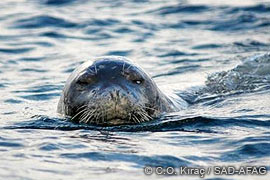 |
|
|
Koca Yusuf along the NW coasts of the Karaburun Peninsula. |
Luckily, Koca Yusuf was located very quickly along the shores of an off-lying island. The observation on 15.12.2005 lasted almost 5 hours, during which 44 diving sessions were carefully recorded. The mean dive duration was a little greater than 5 minutes – lower than that presented in the aforementioned Monachus Science article. The dive pattern was typical, consisting of continuous “spot diving” made within a 30-40m diameter area near the rocky shore. Koca Yusuf was observed and photographed from distances ranging between 100 to 15m; the seal did not display any reaction of fear or anxiety towards its observers.
Onsite observations, coupled with a later study of the photographic record, revealed that the animal appears to be blind in the left eye, and that the right eye could only be partially opened.
Otherwise, Koca Yusuf seemed healthy, the injury having no discernable impact on his diving and foraging. The seal is the only known resident adult male monk seal in the Karaburun area, making his survival all the more important for a possible recovery of the species in the area. – Cem Orkun Kirac, SAD-AFAG.
There have been a number of conservation efforts to protect the Mediterranean monk seal on the Turkish coasts. All these efforts, in one way or another, brought new regulations restricting human activities. In some cases, these regulations were requested by the local people themselves. For instance, in the case of the Cilician colony, the coastal fishermen who slaughtered at least 6 monk seals in 1994 demanded a ban on trawling in the area to stop the killing. The trawler owners subsequently agreed to the ban, provided that the coastal 3-mile trawl exclusion zone was reduced to 2 miles in the rest of the fishing ground. That was a regulation proposed and set forth by the involvement of the local fisheries community. With this agreement, small-scale fishermen received a greater share of the trawl-free coastal fish stocks; the large-scale trawlers expanded their legal fishing grounds and the monk seals were saved from slaughter.
The regulations are published in the Fisheries Circulars but there, the history behind a decree is naturally disregarded. When a fisherman outside that fishing area reads the fisheries circular, he just sees the line declaring that “area X is banned for trawling because of the monk seal”. For the majority of the fishermen, monk seal conservation equals limitations on their fishing activities, and is hence something to resist.
The Middle East Technical University Institute of Marine Sciences has carried out research on an almost unknown colony of monk seals in the Gulf of Iskenderun. As a part of the research, the fishermen of the area were asked to report seals sighted around the gulf. At first, the fishermen of the area were reluctant to talk about seals. Later, it became evident that they did not want to lose their fishing rights because of the seal’s presence. Their fear was seeded by the reason given above: a huge area in the neighbouring Cilician coast is closed to fishing in order to protect the seals.
It is evident that any seal conservation attempt on the Mediterranean coast disregarding the attitude of the local fishermen is predisposed to failure. Going on this premise, we believe that there is an urgent need for a model facilitating mutually beneficial coexistence between seal and fisherman. With this aim in mind, the Levant Nature Conservation Society launched a project called ECO-FISH, supported by the Small Investments Fund Project, a collaborative effort between the BTC pipeline company and UNDP (United Nations Development Programme). The project has two main objectives. The first, which is already accomplished, is to unify small-scale fishermen living close to the seal habitats and practicing non-detrimental fishing. Following a series of meetings and lobbying activities, the Meydan fisheries cooperative has been launched in Samandag, located next to the Syrian border. The members of the cooperative have signed a memorandum of understanding that membership is valid only as long as they use non-detrimental fishing techniques.
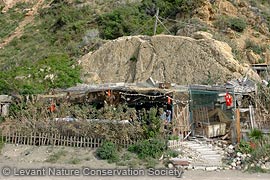 |
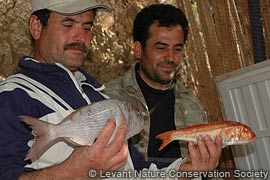 |
|
|
Meydan fisheries cooperative and members. |
||
Marketing the catch is listed as the main problem affecting the fishery by targeted fishermen. Factors such as remoteness of the site to the main fish market, involvement of middle-men and fish mongers in marketing, costs of transportation, etc. significantly lowers the price of the fish at the landing site. The second objective of the Eco-fish project is to create an Internet based market for the products of the cooperative. In an attempt to increase the unit price of the fish and secure the quality of the product during transportation, the landings of the cooperative will first be processed in a workshop run by the local women. The fish, prepared according to traditional recipes and with additional local produce, will be sent straight to consumers.
Buying fish from Meydan fisheries cooperative, consumers will know that:
Being a member of the cooperative, the fishermen will know that:
Finally, being around, the seal will be better treated and appreciated. – Ali Cemal Gucu, Levant Nature Conservation Society.
Terrestrial access to a frequently used monk seal cave in the Cilician region has been blocked to stop human disturbance. This activity was organised by the Levant Nature Conservation Society in July 2005, with the help of volunteers. The cave had two outer openings. An iron railing was used to close up one opening so as to preserve wave dynamics inside the cave, while the other was sealed by a stone wall compatible with natural surroundings.
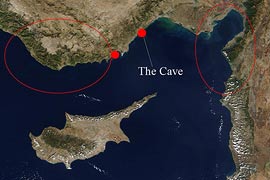 |
|
|
Location of the seal colonies and the cave. |
The cave is located on a midpoint between the Gulf of Iskenderun and the Cilician region. This potential bridge between two isolated sub-populations is necessary for the small colony in the Gulf of Iskenderun to survive [see Is the broken link between two isolated colonies in the northeastern Mediterranean re-establishing? TMG 7 (2): November 2004]. The Middle East Technical University – Institute of Marine Science (METU – IMS), which carried out research and conservation efforts in the region up until 2005, initially registered this cave as abandoned in its cave inventory, with evidence suggesting that it had not been used by seals in 10 years. Since a first surprise sighting in October 2004, however, a young female had been regularly observed. Because her movements were unusually slow and her belly swollen, we believed that she might be pregnant. She did not, however, give birth in the cave.
Regular checks also showed us that the cave was frequently visited by human intruders, a severe threat for any monk seal that might use the cave for resting or breeding purposes. The presence of intruders also hinders the installation of expensive monitoring equipment because of the risk that it might be stolen or damaged.
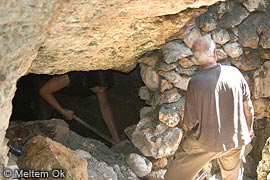 |
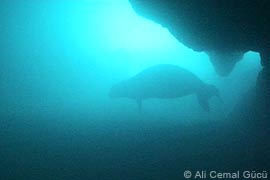 |
|
|
Building the wall. |
The female seal entering the cave. |
So as to eliminate this risk, the Levant Nature Conservation Society sealed the land openings of the cave with the permission of the Ministry of Environment and Forestry.
Further information and photographs about the Society’s work can be obtained from the Society’s web site: http://www.ecocilicia.org/. – Serdar Sakinan, Levant Nature Conservation Society.
Levant Nature Conservation Society, based in Mersin, is a newly established NGO targeting conservation of both terrestrial and marine ecosystems in the eastern Mediterranean. The founders of the society mainly consist of the members of the monk seal research team of the Middle East Technical University – Institute of Marine Sciences (METU-IMS). Programmes carried out by the Institute necessarily had research as their first priority and therefore were often not eligible for funding under educational or social improvement grant mechanisms. Recognizing the necessity of public outreach, the METU-IMS team subsequently decided to establish an NGO to further this mission to implement a conservation science that is of benefit to local people.
The first project carried out by the society in 2005 was the closure of the land openings of a Cilician monk seal cave in Mersin [see preceding story].
The next and still-ongoing project is the “Antakya Samandag Meydan Village Sea Friendly Fisheries project,” funded by UNDP-SGP [see Eco-fish, above].
To help or join the society, please visit the webpage www.ecocilicia.org and/or write to us at contact@ecocilicia.org. – Billur Çelebi, president of management board, Levant Nature Conservation Society.
In order to enhance the capacity and capability of SAD-AFAG to rescue and rehabilitate endangered Mediterranean monk seals in Turkish coastal waters, SAD-AFAG and the Seal Rehabilitation and Research Centre (SRRC) in Pieterburen, the Netherlands, have reached an agreement in principle on operations in Turkey.
According to the agreement, SRRC will provide, wherever possible, practical training on first aid, rescue and rehabilitation and pathology (veterinary aspects), either in Turkey, in the Netherlands or, where appropriate, in a third country. SRRC will assist SAD in setting up a mobile rehabilitation unit by providing the required know-how to build one in Turkey. – Harun Güçlüsoy, SAD-AFAG.
EndQuotePhocaea Islands and the Siren Rocks The islands nearby the ancient city of Phocaea (modern day Foça), attract tourists from all over the world to watch its marvelous sunsets over the Siren Rocks against the backdrop of the beautiful Aegean Sea. Playing on the rocks are the Mediterranean monk seals (Monachus monachus), whose population in the world has decreased to 400. Conservation efforts to preserve and enhance the population of this threatened species are ongoing.
|
Copyright © 2006 The Monachus Guardian. All Rights Reserved |